Accommodation · Asia · Attractions · Going Out · Hotels · Japan · Regions
6 recommended spots for your trip to Tokyo
Given that Tokyo is the largest metropolitan area in the world, home to over 36 million people, over 4,000 temples and shrines, and limitless attractions, things to do and see and places to eat, it can feel like an overwhelming place to visit. Don’t skip it, though! A little insider knowledge makes all the difference – which is why we spoke to the Shinagawa Prince Hotel – experts in helping their visitors on a daily basis to navigate the best things to do, see and eat in the pulsing behemoth they call home. Here are their top six recommendations of places to see to get you started on your Tokyo tour.
1. Gotenyama Garden in Shinagawa
Ease into Tokyo with a visit to Gotenyama Garden – a local-knowledge gem of a garden in the heart of the Shinagawa business district. Few tourists know of this peaceful 6,800 m2 garden, making it a perfectly zen start to your tour of Tokyo. No matter what time of year you visit, this four-season mini-paradise offers something to marvel at, but from late March to early April you’re in for a cherry blossom bonanza, while from mid November to early December autumn leaves give exquisite respite from the concrete, glass and traffic in the city beyond.
 2. Sengakuji Temple
Staying in Shinagawa, head to Sengakuji, a small temple near Shinagawa Station. Famous for its graveyard where the ‘47 Ronin’ or ‘47 Samurai’, also known as Akoroshi – the ‘masterless samurai from Ako’, are buried, this temple, on its present site, dates back to 1641. During the Edo era, Sengakuji was one of the three major temples of old Edo (now Tokyo). A festival is held annually on December 14 at Sengakuji, attracting thousands of visitors who come to pay respect to the samurai by burning incense sticks in the tiny graveyard.
2. Sengakuji Temple
Staying in Shinagawa, head to Sengakuji, a small temple near Shinagawa Station. Famous for its graveyard where the ‘47 Ronin’ or ‘47 Samurai’, also known as Akoroshi – the ‘masterless samurai from Ako’, are buried, this temple, on its present site, dates back to 1641. During the Edo era, Sengakuji was one of the three major temples of old Edo (now Tokyo). A festival is held annually on December 14 at Sengakuji, attracting thousands of visitors who come to pay respect to the samurai by burning incense sticks in the tiny graveyard.
 3. Asakusa Temple (Sensō-ji)
In a city brimming over with temples, a must stop is Sensō-ji, Tokyo’s oldest. Founded in 628 AD, this temple boasts almost one and a half millennia of history, along with some of Tokyo’s most iconic landmarks, Kaminarimon Gate being a case in point. Start your visit to Sensō-ji here before wandering up towards Hondo, the main temple, along Nakamise Dori, a street lined with shops – some souvenir and some dating back 100 years! Once you get to Hondo (open 6am-5pm daily), wander up the stairs and look around. Insider tip: look up! Some of the greatest artworks from Sensoji’s collection are painted directly on the ceiling or are hanging on the upper walls.
3. Asakusa Temple (Sensō-ji)
In a city brimming over with temples, a must stop is Sensō-ji, Tokyo’s oldest. Founded in 628 AD, this temple boasts almost one and a half millennia of history, along with some of Tokyo’s most iconic landmarks, Kaminarimon Gate being a case in point. Start your visit to Sensō-ji here before wandering up towards Hondo, the main temple, along Nakamise Dori, a street lined with shops – some souvenir and some dating back 100 years! Once you get to Hondo (open 6am-5pm daily), wander up the stairs and look around. Insider tip: look up! Some of the greatest artworks from Sensoji’s collection are painted directly on the ceiling or are hanging on the upper walls.
 4. Tokyo Tower
Think Tokyo Tower looks familiar? Yes, it was originally inspired by the Eiffel Tower in Paris, France! That doesn’t make it any less a symbol of Tokyo, though. This communications and observation tower in the Shiba-Koen district has an observation deck from where you can look out over the city and, at 332.9 meters, it’s quite the view! Even though it’s only the second-tallest structure in Japan, after the Tokyo Skytree, it’s definitely worth the 600-step climb to the main deck and the birds eye view of the city. Never fear, you can also take an elevator, which will also take you even higher up to the Top Deck and an even more spectacular view.
4. Tokyo Tower
Think Tokyo Tower looks familiar? Yes, it was originally inspired by the Eiffel Tower in Paris, France! That doesn’t make it any less a symbol of Tokyo, though. This communications and observation tower in the Shiba-Koen district has an observation deck from where you can look out over the city and, at 332.9 meters, it’s quite the view! Even though it’s only the second-tallest structure in Japan, after the Tokyo Skytree, it’s definitely worth the 600-step climb to the main deck and the birds eye view of the city. Never fear, you can also take an elevator, which will also take you even higher up to the Top Deck and an even more spectacular view.
 5. Zojoji Temple
If you think Zojoji Temple looks familiar too, that’s because you probably recognize it as the Wolverine Temple from the X-Men series: Zojoji Temple’s main hall was used for Mr.Yashida’s funeral. Pop culture references aside, Zojoji Temple is actually one of the most important temples in Japan, serving as the head temple of the Jodo sect of Japanese Buddhism in the Kanto Region. Built in 1393, it was moved to the current location in 1598 by the order of the Great shogunate of Edo period, Ieyasu Tokugawa. Here it serves as the final resting place for six Tokugawa shoguns, including Ieyasu himself.
5. Zojoji Temple
If you think Zojoji Temple looks familiar too, that’s because you probably recognize it as the Wolverine Temple from the X-Men series: Zojoji Temple’s main hall was used for Mr.Yashida’s funeral. Pop culture references aside, Zojoji Temple is actually one of the most important temples in Japan, serving as the head temple of the Jodo sect of Japanese Buddhism in the Kanto Region. Built in 1393, it was moved to the current location in 1598 by the order of the Great shogunate of Edo period, Ieyasu Tokugawa. Here it serves as the final resting place for six Tokugawa shoguns, including Ieyasu himself.
 6. Shinagawa Shrine
Built in 1187 as a part-time residence to the god Amanohiranomenomikoto, Shinagawa Shrine is one of the Tokyo-jissha, the 10 shrines of Tokyo forming a ring around the Imperial Palace. These were appointed by the Emperor Meiji as symbols of a new era and as places of worship to pray for the nation’s prosperity. As such you will find many pilgrims to Shinagawa Shrine, so don’t expect to have it to yourself. (You can even wash your money for good luck at the Ana Inari Shrine here – little wonder it gets busy!) A visit here is well worth it though for its historical and religious significance.
6. Shinagawa Shrine
Built in 1187 as a part-time residence to the god Amanohiranomenomikoto, Shinagawa Shrine is one of the Tokyo-jissha, the 10 shrines of Tokyo forming a ring around the Imperial Palace. These were appointed by the Emperor Meiji as symbols of a new era and as places of worship to pray for the nation’s prosperity. As such you will find many pilgrims to Shinagawa Shrine, so don’t expect to have it to yourself. (You can even wash your money for good luck at the Ana Inari Shrine here – little wonder it gets busy!) A visit here is well worth it though for its historical and religious significance.
 To make your introduction to Tokyo even more manageable, you can use the handy map below, showing Shinagawa Prince Hotel and all six top spots, as your guide.
Trust us though: Tokyo and her energy are guaranteed to suck you in – once you’ve made your stops at these six spots you’ll be ready and willing to tackle everything she can throw at you!
Disclosure: This post is sponsored by Prince Hotels and Resorts.
To make your introduction to Tokyo even more manageable, you can use the handy map below, showing Shinagawa Prince Hotel and all six top spots, as your guide.
Trust us though: Tokyo and her energy are guaranteed to suck you in – once you’ve made your stops at these six spots you’ll be ready and willing to tackle everything she can throw at you!
Disclosure: This post is sponsored by Prince Hotels and Resorts.
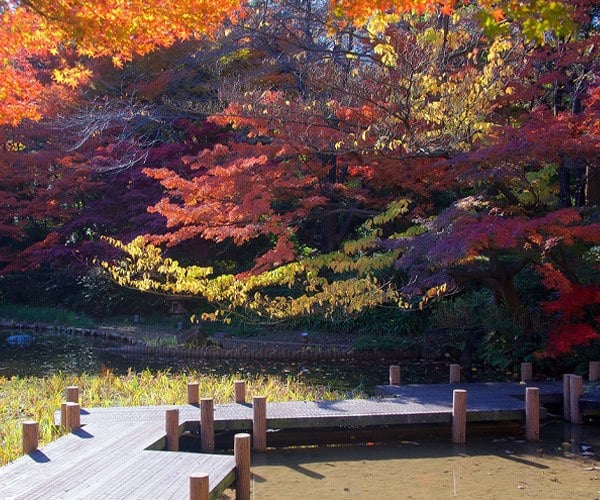 2. Sengakuji Temple
Staying in Shinagawa, head to Sengakuji, a small temple near Shinagawa Station. Famous for its graveyard where the ‘47 Ronin’ or ‘47 Samurai’, also known as Akoroshi – the ‘masterless samurai from Ako’, are buried, this temple, on its present site, dates back to 1641. During the Edo era, Sengakuji was one of the three major temples of old Edo (now Tokyo). A festival is held annually on December 14 at Sengakuji, attracting thousands of visitors who come to pay respect to the samurai by burning incense sticks in the tiny graveyard.
2. Sengakuji Temple
Staying in Shinagawa, head to Sengakuji, a small temple near Shinagawa Station. Famous for its graveyard where the ‘47 Ronin’ or ‘47 Samurai’, also known as Akoroshi – the ‘masterless samurai from Ako’, are buried, this temple, on its present site, dates back to 1641. During the Edo era, Sengakuji was one of the three major temples of old Edo (now Tokyo). A festival is held annually on December 14 at Sengakuji, attracting thousands of visitors who come to pay respect to the samurai by burning incense sticks in the tiny graveyard.
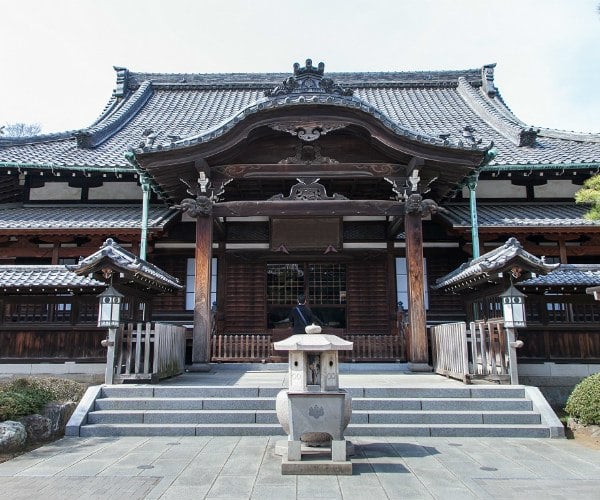 3. Asakusa Temple (Sensō-ji)
In a city brimming over with temples, a must stop is Sensō-ji, Tokyo’s oldest. Founded in 628 AD, this temple boasts almost one and a half millennia of history, along with some of Tokyo’s most iconic landmarks, Kaminarimon Gate being a case in point. Start your visit to Sensō-ji here before wandering up towards Hondo, the main temple, along Nakamise Dori, a street lined with shops – some souvenir and some dating back 100 years! Once you get to Hondo (open 6am-5pm daily), wander up the stairs and look around. Insider tip: look up! Some of the greatest artworks from Sensoji’s collection are painted directly on the ceiling or are hanging on the upper walls.
3. Asakusa Temple (Sensō-ji)
In a city brimming over with temples, a must stop is Sensō-ji, Tokyo’s oldest. Founded in 628 AD, this temple boasts almost one and a half millennia of history, along with some of Tokyo’s most iconic landmarks, Kaminarimon Gate being a case in point. Start your visit to Sensō-ji here before wandering up towards Hondo, the main temple, along Nakamise Dori, a street lined with shops – some souvenir and some dating back 100 years! Once you get to Hondo (open 6am-5pm daily), wander up the stairs and look around. Insider tip: look up! Some of the greatest artworks from Sensoji’s collection are painted directly on the ceiling or are hanging on the upper walls.
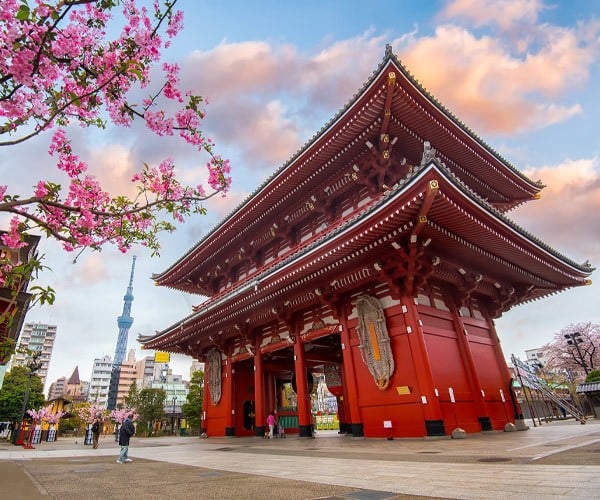 4. Tokyo Tower
Think Tokyo Tower looks familiar? Yes, it was originally inspired by the Eiffel Tower in Paris, France! That doesn’t make it any less a symbol of Tokyo, though. This communications and observation tower in the Shiba-Koen district has an observation deck from where you can look out over the city and, at 332.9 meters, it’s quite the view! Even though it’s only the second-tallest structure in Japan, after the Tokyo Skytree, it’s definitely worth the 600-step climb to the main deck and the birds eye view of the city. Never fear, you can also take an elevator, which will also take you even higher up to the Top Deck and an even more spectacular view.
4. Tokyo Tower
Think Tokyo Tower looks familiar? Yes, it was originally inspired by the Eiffel Tower in Paris, France! That doesn’t make it any less a symbol of Tokyo, though. This communications and observation tower in the Shiba-Koen district has an observation deck from where you can look out over the city and, at 332.9 meters, it’s quite the view! Even though it’s only the second-tallest structure in Japan, after the Tokyo Skytree, it’s definitely worth the 600-step climb to the main deck and the birds eye view of the city. Never fear, you can also take an elevator, which will also take you even higher up to the Top Deck and an even more spectacular view.
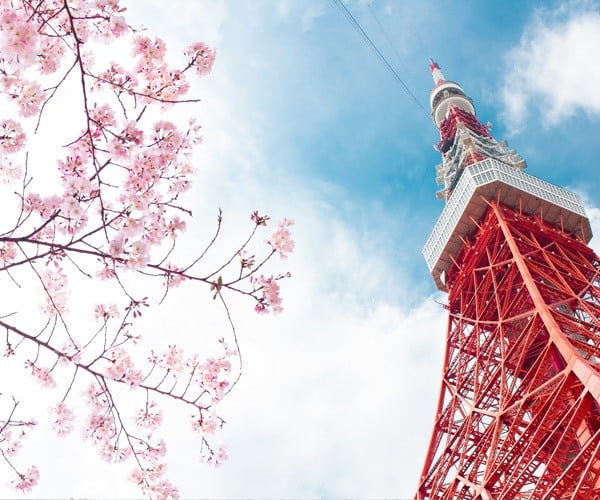 5. Zojoji Temple
If you think Zojoji Temple looks familiar too, that’s because you probably recognize it as the Wolverine Temple from the X-Men series: Zojoji Temple’s main hall was used for Mr.Yashida’s funeral. Pop culture references aside, Zojoji Temple is actually one of the most important temples in Japan, serving as the head temple of the Jodo sect of Japanese Buddhism in the Kanto Region. Built in 1393, it was moved to the current location in 1598 by the order of the Great shogunate of Edo period, Ieyasu Tokugawa. Here it serves as the final resting place for six Tokugawa shoguns, including Ieyasu himself.
5. Zojoji Temple
If you think Zojoji Temple looks familiar too, that’s because you probably recognize it as the Wolverine Temple from the X-Men series: Zojoji Temple’s main hall was used for Mr.Yashida’s funeral. Pop culture references aside, Zojoji Temple is actually one of the most important temples in Japan, serving as the head temple of the Jodo sect of Japanese Buddhism in the Kanto Region. Built in 1393, it was moved to the current location in 1598 by the order of the Great shogunate of Edo period, Ieyasu Tokugawa. Here it serves as the final resting place for six Tokugawa shoguns, including Ieyasu himself.
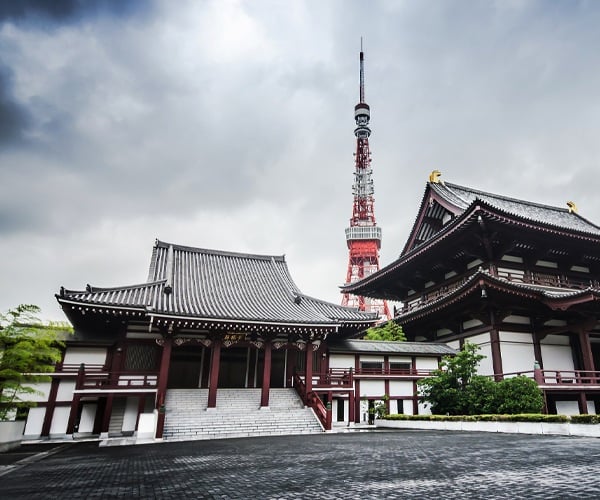 6. Shinagawa Shrine
Built in 1187 as a part-time residence to the god Amanohiranomenomikoto, Shinagawa Shrine is one of the Tokyo-jissha, the 10 shrines of Tokyo forming a ring around the Imperial Palace. These were appointed by the Emperor Meiji as symbols of a new era and as places of worship to pray for the nation’s prosperity. As such you will find many pilgrims to Shinagawa Shrine, so don’t expect to have it to yourself. (You can even wash your money for good luck at the Ana Inari Shrine here – little wonder it gets busy!) A visit here is well worth it though for its historical and religious significance.
6. Shinagawa Shrine
Built in 1187 as a part-time residence to the god Amanohiranomenomikoto, Shinagawa Shrine is one of the Tokyo-jissha, the 10 shrines of Tokyo forming a ring around the Imperial Palace. These were appointed by the Emperor Meiji as symbols of a new era and as places of worship to pray for the nation’s prosperity. As such you will find many pilgrims to Shinagawa Shrine, so don’t expect to have it to yourself. (You can even wash your money for good luck at the Ana Inari Shrine here – little wonder it gets busy!) A visit here is well worth it though for its historical and religious significance.
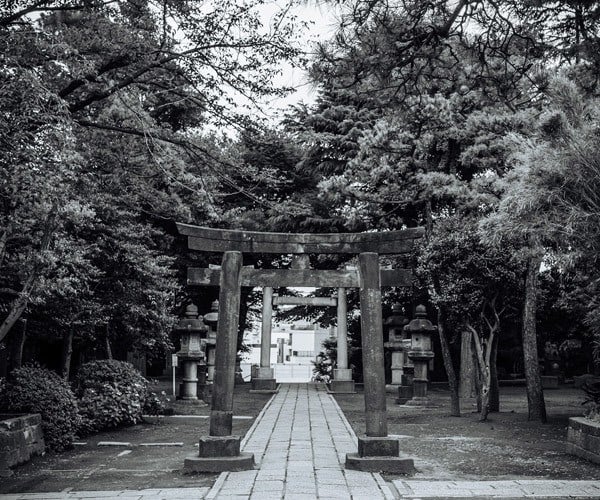 To make your introduction to Tokyo even more manageable, you can use the handy map below, showing Shinagawa Prince Hotel and all six top spots, as your guide.
Trust us though: Tokyo and her energy are guaranteed to suck you in – once you’ve made your stops at these six spots you’ll be ready and willing to tackle everything she can throw at you!
Disclosure: This post is sponsored by Prince Hotels and Resorts.
To make your introduction to Tokyo even more manageable, you can use the handy map below, showing Shinagawa Prince Hotel and all six top spots, as your guide.
Trust us though: Tokyo and her energy are guaranteed to suck you in – once you’ve made your stops at these six spots you’ll be ready and willing to tackle everything she can throw at you!
Disclosure: This post is sponsored by Prince Hotels and Resorts.Did you enjoy this article?
Receive similar content direct to your inbox.


Many of my friends have got Tokyo on their travel bucket list. For those of us who live in Britain it is such a long way and there’s no doubt that the sheer size of the city is quite intimidating too.
Like most of my friends I’ve never made it to Tokyo either. This is a really helpful guide that tells me that I ought to get on and finally organise a trip to Tokyo.
Tokyo, it’s on my list. It has been for a while but I’ve yet to get there. One day in the near future hopefully. These are great suggestions. There must be so much to see and do that you’d want to get a list together to make sure you make the most of your trip, especially if you’re only able to do it as a one in a lifetime kind of deal. Sensō-ji is a must, I’ve often read about that. And Shinagawa Shrine. We’ll have to take some of our plastic fivers to was there, at least they shouldn’t get too soggy. The Shinagawa Prince looks to be in a good location for visiting some of these areas then and not far from Rainbow Bridge by the looks of the map.
More and more as I travel I make use of the hotel’s concierges. After all they spend most of their working day helping people to make the most of their visit.
I’m sure that the Shinagawa Prince Hotel concierge, with the hotel’s central position, would be a really helpful resource when it comes to finding your way around these six sights and many others too.
That incredible photo of the Gotenyama Garden really is your lead poster picture for Tokyo. Zen is one of those words I never get, it gets hijacked for so many different causes that I’ve got very confused. If anyone can enlighten me in a few sentences I’d be very grateful.
This is very useful, especially the map. In big cities like Tokyo I just wouldn’t know where to stay and wouldn’t know how to start putting together what I wanted to see with what would be good places to stay. Some of these big cities can be quite off-putting, for instance where do you stay in Los Angeles or Mexico City? Maybe some more guides in this style on A Luxury Travel Blog would be useful for many of us wannabe travellers.
Some great choices. There’s definitely more than cherry blossoms to Japan and more than the bright lights of the modern buildings in Tokyo. There’s so much history and I love the rich culture. Zojoji would be a good one to see. Stupid question but can tourists go inside at any time bar when there’s some kind of special service?
Very cool article with some great spots to consider. I love the historical context of these places, and the black and white photo was pretty cool as well. The scenery there seems very invigorating, and the recommendation to visit in late-March, early April is something I’m definitely going to consider this year.
Ah, Asakusa and Shinagawa are my favorites when I visited Tokyo about two years ago. That striking red color leaves a lasting impression and a standout in a city filled with tall concrete buildings. And the Shinagawa Shrine is just classic, and reminds me of that scene in the Rurouni Kenshin movie.